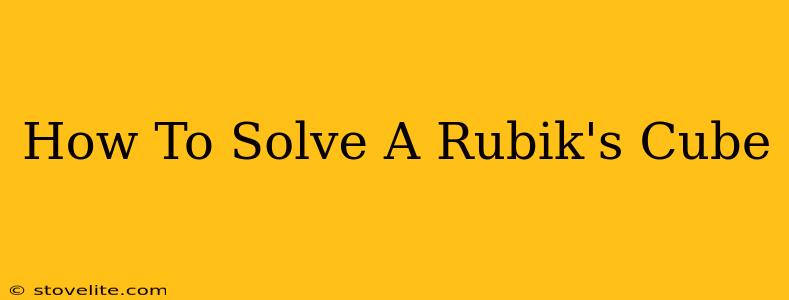The Rubik's Cube: a seemingly impossible puzzle that has captivated minds for decades. Its colorful squares and intricate mechanisms can seem daunting, but with the right approach, solving it becomes achievable, even fun! This guide will walk you through the process step-by-step, breaking down the solution into manageable stages. Get ready to conquer this classic puzzle!
Understanding the Rubik's Cube Notation
Before we begin, it's important to familiarize yourself with the standard notation used to describe Rubik's Cube moves. This will make following the instructions much easier. The notation typically uses single letters to represent a 90-degree clockwise turn of a face:
- F: Front face
- B: Back face
- R: Right face
- L: Left face
- U: Up face
- D: Down face
Adding an apostrophe (') after a letter indicates a 90-degree counter-clockwise turn, and a '2' indicates a 180-degree turn. For example, R' means a counter-clockwise turn of the right face, and F2 means a 180-degree turn of the front face.
The Beginner Method: Solving the Rubik's Cube in 7 Steps
This method breaks the solution down into seven intuitive steps, perfect for beginners. Don't worry about memorizing long algorithms; focus on understanding the logic behind each step.
Step 1: The White Cross
The first step is to create a white cross on the top face (usually the white face). This involves maneuvering the edge pieces with a white sticker to their correct positions, aligning them with the corresponding colored center pieces. It might take some trial and error, but focus on getting the white edges to their correct positions.
Step 2: Completing the White Corners
Once the white cross is complete, the next step is to solve the white corners. This involves bringing the white corner pieces into their correct positions, completing the first layer. Again, patience and practice are key. You'll find yourself naturally developing intuition for moving pieces into their places.
Step 3: The Middle Layer
With the first layer solved, we move on to the middle layer. This step involves bringing the four edge pieces of the middle layer into their correct positions without disturbing the already solved first layer. This might seem tricky, but it involves a series of intuitive moves.
Step 4: The Yellow Cross
Now, we tackle the yellow face. The goal of this step is to create a yellow cross on the top face. Several algorithms exist for this, but you can find a visual approach that works best for you. Try to create a yellow cross as efficiently as possible.
Step 5: Orient the Yellow Edges
Next, we need to orient the yellow edges. This means ensuring that all the yellow edges on the top face are oriented correctly. There are a few simple algorithms that can be used to achieve this.
Step 6: Permute the Yellow Corners
Now we need to position the yellow corners correctly. This involves bringing the yellow corners into their correct locations without disrupting the orientation. This is another step where you'll appreciate visual tutorials.
Step 7: Orient the Yellow Corners
The final step is to orient the yellow corners. This involves rotating the yellow corners into their final correct positions. With the previous steps completed, this should be a straightforward process.
Tips for Success
- Practice Regularly: The key to solving a Rubik's Cube is practice. The more you practice, the faster and more intuitive the process will become.
- Use Visual Tutorials: Many excellent YouTube tutorials are available. Visual aids are invaluable in understanding the movements and algorithms.
- Don't Give Up: Solving a Rubik's Cube takes time and patience. Don't get discouraged if you don't solve it immediately. Keep practicing, and you'll get there!
Beyond the Beginner Method
Once you've mastered the beginner method, you can explore more advanced techniques like CFOP (Fridrich Method) or Roux Method to significantly reduce your solving time. These methods require learning more complex algorithms, but they offer a much faster approach.
Solving a Rubik's Cube is a rewarding experience. Start with the beginner method, practice regularly, and watch yourself progress from a beginner to a Rubik's Cube master!

